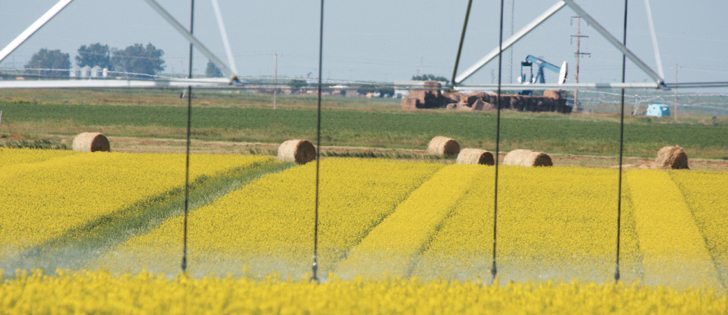Farmers who want to tap into Saskatchewan’s proposed Upper Qu’Appelle water supply project are frustrated by another delay and the possibility that they won’t be able to participate.
The province’s Water Security Agency is undertaking another study of the project, which would convey water from Lake Diefenbaker through the Qu’Appelle Dam to serve the Regina-Moose Jaw corridor, including the cities and the industrial development between them.
The existing natural channel is flowing far below capacity because of silt, erosion and the fact that it meanders. It can’t move the amount of water needed by customers such as potash mines, and previous studies have suggested that a conveyance located above the Qu’Appelle Valley would be the best way to do that. It would also allow for irrigation of 110,000 acres.
Read Also

Farming Smarter receives financial boost from Alberta government for potato research
Farming Smarter near Lethbridge got a boost to its research equipment, thanks to the Alberta government’s increase in funding for research associations.
The cost has been estimated at $1.2 billion but with economic returns of 20 times that amount for at least 50 years.
The provincial cabinet has never committed to the large, expensive project, and last year a consultant said the clock was ticking and decisions had to be made.
However, the WSA is now taking another look at a channel in the valley rather than above it.
“We want to have every option in front of us,” said WSA spokesperson Patrick Boyle.
He said the study is to be complete by June. An economic assessment will also be commissioned.
Farmers at the recent Saskatchewan Irrigation Projects Association annual meeting suggested the intention is to exclude irrigation from the project. Boyle said the needs of all sectors are being examined.
Blaine White, chair of the newly formed Qu’Appelle South Irrigation District (QSID), said any delay in construction and access to water is “incredibly frustrating.”
The new district comprises the rural municipalities of Marquis and Eyebrow, half of the RM of Huron south of the Qu’Appelle Valley and two districts in RM of Maple Bush.
About 29 kilometres of the existing channel near Lake Diefenbaker are within the district, and some irrigation already occurs through private pivots and the 2,500 acre Grainland project.
However, studies done 25 years ago found that 14,000 acres could be irrigated in the RM of Huron alone.
“We have watched the deterioration of the conveyance channel in the valley for years,” said White, who irrigates on his own and as part of Grainland.
“We always considered that perhaps an upland channel would be a great fit to alleviate the problems of getting the water down the valley.”
He said RM councils and farmers have worked for more than 10 years to establish the district, which finally became a legal entity in November.
The next step for the district is to apply for water allocation and soil certification.
“There is a very good idea of the amount of Class 1 soils that could be irrigated, and the way the proposed route was set up, that was to have the ability to irrigate as many of those acres at the least expense,” White said.
Members at the SIPA meeting passed a resolution calling on the province to complete the engineering design and get the project shovel ready as soon as possible. At the same time, the best financing model for construction and operation should be selected.
“We’ve studied this long enough, and I believe the channel that they’re studying in the bottom of the Qu’Appelle Valley doesn’t include irrigation very well,” said Mark Oram, who is part of the new QSID.
“I think we need to move ahead with this upland channel.”
MOOSE JAW, Sask. — The Saskatchewan Irrigation Projects Association expects that a provincial irrigation strategy will be released early next year.
Chair Roger Pederson told the SIPA annual meeting that the province’s crops and irrigation branch has been working for months on the strategy, which SIPA has advocated for years.
He also said the transfer of irrigation assets from the provincial government to irrigation districts is well underway.
“SIPA has indicated the process could proceed much quicker and smoother with the completion of the irrigation strategy.”
The government will continue to own the M1 canal, which is the main water conveyance from Lake Diefenbaker for irrigation, but is transferring pump stations, pipelines and other smaller works to the districts.
Meanwhile, the divestiture of federal irrigation works in southwestern Saskatchewan is still not complete. Pederson said meetings are planned, and he hoped the process would unfold more quickly next year.
“SIPA has supported this process, and our position has been consistent, in that we support viable irrigation in southwest Saskatchewan,” he said.
SIPA members want drainage control
Irrigation districts would like to be able to control their own drainage.
SIPA members passed a resolution at their recent annual meeting noting that farm drainage has become topical after several years of flooding. Irrigation districts already have drainage plans and want the Saskatchewan Water Security Agency to allow drainage to occur within a district’s boundaries using existing outlets and without further approvals.
Vegetable production explored
A study of high-volume vegetable production in Saskatchewan will be complete by the end of this year, said the consultant undertaking the work for SIPA.
Judie Dyck said she has met with growers and retailers as part of her work. Growers must be aware that they have to meet both Canadian Food Inspection Agency and particular retailers’ specifications and standards.
“The trend for local produce is a real opportunity for Saskatchewan,” she said. “Consumers want to see local produce in stores.”
Dyck said a lack of statistics about the industry has been a major challenge.
Establishing benchmarks is important to help growers obtain financing and crop insurance and build confidence in the industry, she added.


















